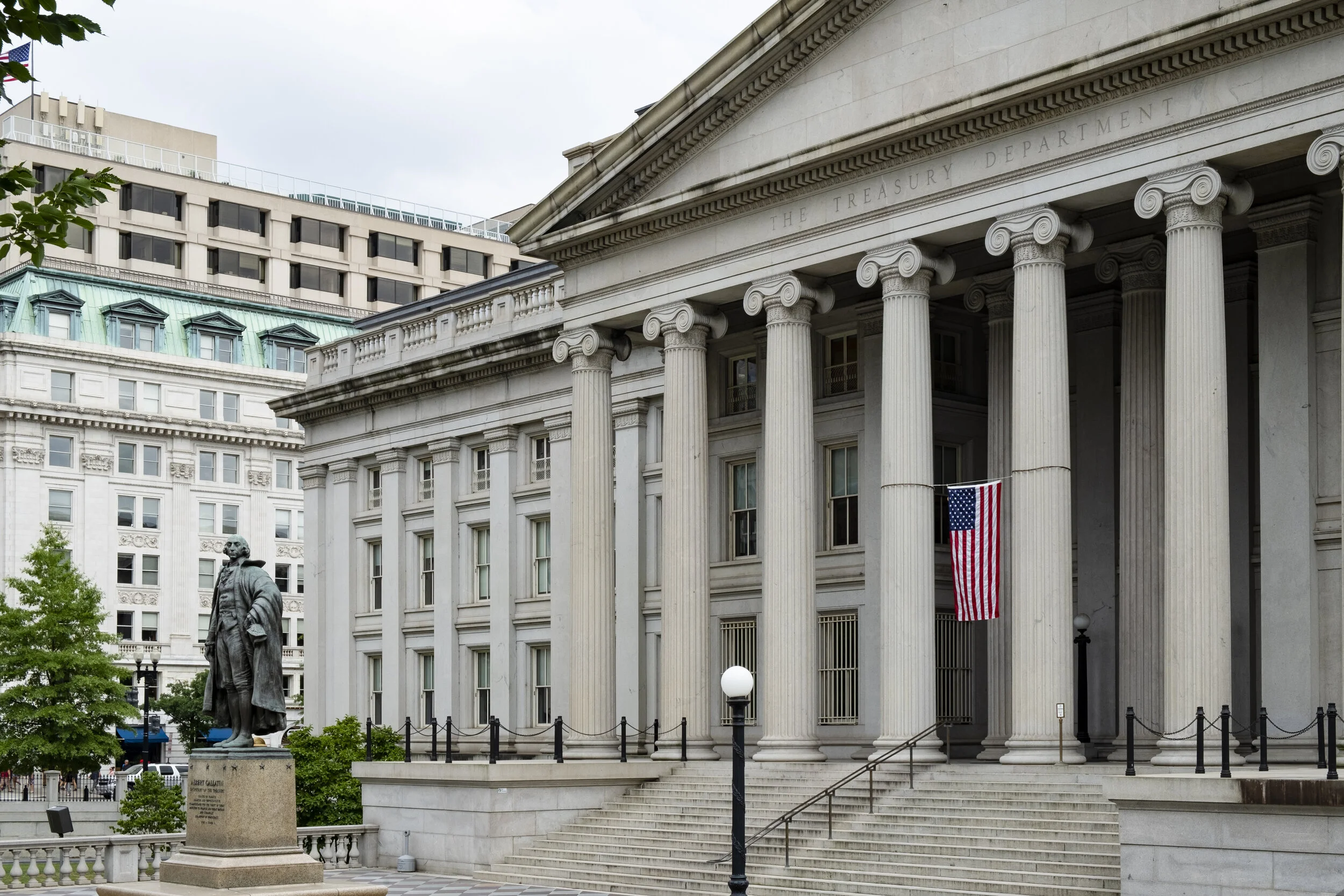PWBM projects that the revenue-raising provisions in the House Ways and Means Reconciliation Bill would raise roughly $2.4 trillion from 2022 to 2031.
The Macroeconomic Effects of the August 2021 Senate Budget Reconciliation Package
Drafting a budget from the August 2021 Senate reconciliation framework that satisfies the Senate rules of reconciliation (“Byrd Rule”) will require a decrease in new outlays or a large increase in revenues (or both) after the standard 10-year budget window.
One such potential reduction in spending would allow the new non-healthcare related discretionary spending provisions to expire after 2031.
With this reduced spending in 2031, we project that the reconciliation package will decrease GDP by 4.0 percent in 2050. Without this spending decrease (and where the Byrd Rule is not satisfied), we project a 4.8 percent fall in GDP in 2050.
Economic Effects from Preschool and Childcare Programs
By 2051, we find that a combination of targeted preschool and targeted childcare programs increase GDP by 0.1 percent relative to current policy, even if deficit financed. Universal versions of these programs are more costly and would instead reduce GDP by 0.2 percent by 2051.
Budgetary Offsets for Democrats’ Reconciliation Package: Options
We analyze a combination of net revenue raisers consistent with the requirements released by the Senate Budget Committee on August 9th, 2021, for budget reconciliation.
Updated Bipartisan Senate Infrastructure Deal: Budgetary and Economic Effects
The bipartisan Senate infrastructure deal, endorsed by President Biden, authorizes about $548 billion in additional infrastructure investments, which we estimate is funded by $132 billion in new tax provisions and $351 billion in new deficits. We project that proposal would have no significant effect on GDP by end of the budget window (2031) or in the long run (2050).
Profit Shifting and the Global Minimum Tax
We estimate that the recent OECD proposal for a global minimum tax would triple the effective U.S. tax rate on foreign income from 2 percentage points to 5.8 percentage points. The Biden administration’s proposed changes to the U.S. global minimum tax regime would instead raise the effective U.S. tax rate on foreign income to 12.4 percentage points.
President Biden’s FY2022 Budget Proposal: Budgetary and Economic Effects
PWBM estimates that President Biden’s FY2022 budget proposal would increase spending by $6.1 trillion and increase revenue by $3.9 trillion over the 2022-2031 budget window. By 2050, we project that the President’s budget proposals would decrease public debt by 5.1 percent and decrease GDP by 1.5 percent relative to current law.
Effects of President Biden’s Unauthorized Immigrant Legalization Proposal on SNAP and Payroll Tax
PWBM projects that the legalization provisions of the U.S. Citizenship Act proposed by President Biden would increase per capita spending on the Supplemental Nutrition Assistance Program (SNAP) by 1.2 percent in 2030 and 0.8 percent 2050 relative to the current policy baseline. Per capita payroll taxes would decrease by 0.1 percent relative to the current policy baseline.
Bipartisan Senate Infrastructure Deal: Budgetary and Economic Effects
The bipartisan Senate infrastructure deal, endorsed by President Biden, authorizes $1.2 trillion of spending, representing about $579 billion in additional infrastructure investments funded by a mix of deficits, user fees, and other tax provisions. This proposal would increase output in 2050 by 0.1 percent.
Republican and Bipartisan Infrastructure Proposals: Budget and Economic Effects
We estimate that Sen. Capito’s $330 billion infrastructure package, funded by user fees over 8 years, would increase GDP by about 0.05 percent in 2050. A $579 billion infrastructure investment being considered by a bipartisan group of senators, would increase output in 2050 by 0.1 percent if funded by user fees or have roughly zero net effect on GDP if deficit financed.
President Biden's American Families Plan: Budgetary and Macroeconomic effects
PWBM projects that the American Families Plan (AFP) would spend $2.5 trillion, about $700 billion more than the White House’s estimate, over the 10-year budget window, 2022-2031. We estimate that AFP would raise 1.3 trillion in new tax revenue over the same period. By 2050, the AFP would increase government debt by almost 5 percent and decrease GDP by 0.4 percent.
Corporate Debt: Historical Perspective and Options for Reducing Interest Deductibility
While corporations are at historically high levels of debt relative to assets, leverage remains close to its historical average relative to firms’ market value and relative to interest expense as a fraction of cashflow. In PWBM’s dynamic firm model, reducing the deductibility of interest expenses by 10 percentage points decreases corporate output by 0.26 percent while decreasing corporate debt by 6.76 percent.
President Biden’s $2.7 Trillion American Jobs Plan: Budgetary and Macroeconomic Effects
PWBM projects that the American Jobs Plan proposed by President Biden would spend $2.7 trillion and raise $2.1 trillion dollars over the 10-year budget window 2022-2031. The proposal’s business tax provisions continue past the budget window, decreasing government debt by 6.4 percent and decreasing GDP by 0.8 percent in 2050, relative to current law.
Demographic and Economic Effects of President Biden's Proposal to Legalize Immigrants
PWBM projects that by 2050, the legalization provisions of the U.S. Citizenship Act proposed by President Biden would increase the size of the U.S. population by 4.21 percent, increase GDP by 0.5 percent, but decrease GDP per capita by 0.2 percent. More specific legalization proposals targeted at farm workers, DACA recipients, and essential workers would each increase GDP per capita by 0.1 percent in 2050.
Health and Economic Effects of Reducing COVID-19 Vaccine Hesitancy
PWBM projects that vaccinating all those eligible by reducing vaccine hesitancy would prevent up to 8.3 million cases in 2021, increase employment by 2.6 million in December 2021, and boost Q4 2020 to Q4 2021 GDP growth by 2 percentage points. In fact, failure to reduce vaccine hesitancy could lead to a “perfect storm” if people also become optimistic and increase their social contact rates beyond the baseline rates that we previously projected. Indeed, increasing social contact rates to 85 percent of pre-COVID levels by the end of 2021 would lead to up to 4.6 million additional COVID-19 cases in 2021.
Budgetary and Economic Effects of Senator Elizabeth Warren’s Wealth Tax Legislation
PWBM projects that the Ultra-Millionaire Tax Act of 2021, introduced by Senator Elizabeth Warren, would raise $2.1 trillion over the standard 10-year budget window (2022-2031) under scoring conventions used by government agencies. Incorporating the effects of enhanced IRS enforcement, our projection rises to $2.4 trillion over 2022-2031 and $2.7 trillion over 2023-2032. Also incorporating macroeconomic effects of the Act reduces estimated revenue to $2.0 trillion over 2022-2031 and $2.3 trillion over 2023-2032. We estimate that the Act would reduce GDP by 1.2 percent in 2050.
COVID-19: Cost of virtual schooling by race and income
PWBM estimates that schools in the Philadelphia and surrounding suburb districts with more Black students are less likely to reopen with in-person instruction relative to schools with more White students, even after controlling for differences in income by district. By March 2021, Black students in grades K-5 have incurred a 11.9 percent loss in lifetime income from school closures while White students have lost 10.4 percent. Students educated in the city face larger losses than students educated in the surrounding suburbs.
Epidemiological and Economic Effects of the COVID-19 Vaccine in 2021
This brief analyzes the epidemiological and economic effects of maintaining, increasing, or decreasing the current pace of daily COVID-19 vaccinations. PWBM projects that doubling the number of vaccine doses administered daily would boost employment by more than 2 million and real GDP by about 1 percent over the summer of 2021, with smaller effects later in the year.
PWBM Budget Contest: Privately-Organized Universal Health Insurance in the U.S.
This brief analyzes the impact on health insurance premiums, out-of-pocket spending, and the economy for the healthcare proposal from Daniel Evan McGary as part of the PWBM Democratizing the Budget Contest.
Direct Aid in the Biden COVID Relief Plan: Budgetary and Distributional Effects
PWBM estimates that three provisions in the Biden COVID relief plan—direct payments, expanding the Child Tax Credit, and expanding the Earned Income Tax Credit—together would cost $595 billion in calendar year 2021, with 99 percent of households in the bottom 80 percent of incomes receiving a benefit.





















